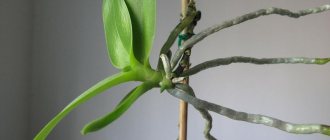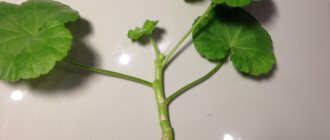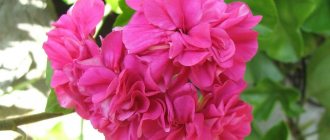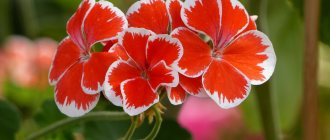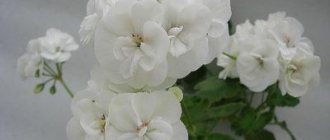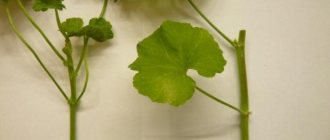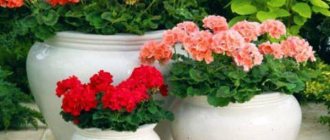Geranium (or pelargonium) is a fairly popular type of indoor plant. The uniform distribution of lush green leaves and ball-shaped inflorescences blooming for a long period of time only during the first two years constantly delight their owner, without causing him any trouble.
Subsequently, as the flower grows, a gradual lignification of the stem occurs, as a result of which the leaves fall off, the bush no longer looks fluffy, and scanty color ovaries appear only at the tip of the shoot, turning the once beautiful pelargonium into an asymmetrical, dryish specimen. Therefore, in order to preserve the plant’s decorative function, it is recommended to carry out cuttings of geraniums at home every three years.
Selecting the time for cuttings
Manipulations related to interference with the biological structure of a flower should be carried out taking into account its annual cycle. Otherwise, propagation by geranium cuttings may not bring the desired result: the flower may not take root, lose its specific characteristics, or become vulnerable to all kinds of parasites and diseases. To prevent this from happening, it is advisable to cut geraniums in the spring (March-April) or autumn (August-September) period.
Important! In aging pelargonium, the ability to form new roots weakens or completely disappears. The reason for this state of affairs is a slowdown in the plant’s metabolic process, as well as a decrease in water-holding capacity. To prevent this from happening, it is recommended to strictly adhere to the timing of flower renewal.
In some cases, when it is necessary to save a dying flower, emergency cuttings are allowed, regardless of the time of year.
Is it possible to plant like this?
Due to the ability of geranium to survive and continue to grow even in unfavorable conditions, it can be propagated without the use of roots. But in general there are three ways to propagate this crop:
- seeds;
- division of roots;
- cuttings.
The first method takes too much time and patience, because in order to germinate the seeds, you need to provide strictly defined conditions, the second is quite risky, since the delicate roots are very easy to damage during their division, but the third, by cuttings, is preferred by most people involved in growing and breeding geraniums.
The main advantage of this method is the ability to propagate a plant without disturbing its roots, which guarantees the complete safety of the mother plant.
Propagation by cuttings gives almost one hundred percent positive results in a relatively short period of time.
How to take cuttings correctly
14–20 days before cuttings, you must stop watering the flower. To avoid dehydration and death of pelargonium, you can feed the plant with a solution of wood ash, which is prepared by mixing 1 liter of water with 20 grams of ash. During the preparation period, geraniums are moved to a shaded room. In this way, you can stimulate the formation of new shoots and significantly speed up the process of formation of new root shoots.
Geranium cuttings are cut from the mother plant using a sharp tool (knife, pruning shears). The cut area is sprinkled with crushed coal. During the selection process, it is necessary to select shoots that have a healthy appearance, as well as 3 well-developed internodes. After making the cut, it is necessary to remove the lower leaves of the inflorescences and dry the shoots, leaving them in a dark room until a thin film forms at the cut site (usually this takes about 2-3 hours). But when removing leaf blades, do not overdo it. After all, leaves are the only source of nutrition for pelargonium shoots, and the intensity of growth of new root shoots depends on them. Therefore, only the lower plates should be cut.
Since pelargonium is half a succulent, which is characterized by rapid decay after the integrity of their shell is damaged, drying is a mandatory step.
Important! The shoots are cut at an angle of 90° relative to the stem. It is also necessary to ensure that the cut site is located 0.5 cm below the node.
Differences between an ivy-leaved plant and a regular one
Important. Ampelous geranium received its name due to its well-developed, flexible, flowing shoots, the length of which can reach 90 cm.
The ordinary geranium has an erect, small stem.
The ampelous variety differs not only in the length of the shoots, but also in the leaves. Geranium leaves have a velvety surface, while geranium leaves have a leaf blade:
- smooth;
- dense;
- leathery.
Outwardly, it resembles an ivy leaf, which is why the plant is sometimes called “ivy-leaved pelargonium.”
Peduncles form in the axils of the leaves.
The flowers of ampelous geranium are up to 4 cm in diameter, collected in large umbrella inflorescences. Depending on the variety, the flowers can be single or double.
The color of the petals is bright and spectacular, in all shades of pink and red. Some hybrid varieties have spots and stripes of contrasting colors or borders on the petals.
Ampelous species are very popular among flower growers and landscape designers. Unlike other types, the ampel form has a number of advantages:
- care is not difficult;
- can be grown as a perennial form indoors or as an annual form in the garden;
- long flowering period from spring until the first autumn frosts;
- suitable for decorating hanging gardens;
- tolerates direct sunlight well;
- drought-resistant;
- tolerates slight drops in temperature well.
Attention. The plant has the only drawback - with high humidity, the root system and stems of geraniums rot.
Rooting in water
Rooting geranium cuttings in water is the easiest and most affordable way to propagate pelargonium at home. In order for the shoot to produce new roots, it is placed in a small container filled with water at room temperature. To prevent new root shoots from rotting, add a little coal chips to the water, which will have a disinfecting effect.
After new roots appear at the tip of the cutting, it is transplanted into the ground. They care for such plants in the same way as for ordinary, adult pelargonium. If you decide to propagate your geranium by cuttings in water, be sure to monitor the temperature conditions. In the room where the container with the young cutting is located, it should be about +14 - +16 °C. Otherwise, the cutting may not produce roots or rot.
Rooting in water is not universal and is not suitable for all types of pelargonium . If you are propagating Royal geraniums, this method will not work. In water, the cuttings of this plant are so quickly affected by putrefactive microorganisms that the shoot simply does not have time to sprout root formations. For such varieties of flowers, rooting in the ground is more suitable.
Possible problems and solutions
Sometimes cuttings can remain in water for a long time without forming roots.
Why geranium does not take root in water:
- air temperature above 25 degrees , and this has a bad effect on the development of roots;
- ivy geranium , and this species can be nourished by internal juices for a long time and not take root.
What to do to make roots appear:
- remove the cutting from the water;
- update slice;
- dry overnight;
- In the morning, plant in slightly moist soil.
How to root geraniums using cuttings
This method of propagation is much more common than the previous one, especially among experienced gardeners. Experts strive in advance to protect their pet from the effects of putrefactive bacteria and initially provide the root formation process with the proper conditions.
Growing geraniums at home using soil is not difficult. The soil mixture should be loose and nutritious. To create a suitable consistency, you can add a little sand to the substrate. To root geraniums, you will need a small plastic cup or flower pot filled with appropriate soil. If you use a plastic cup, be sure to cut holes in the bottom so that moisture after watering does not accumulate in the soil, but comes out.
It is also necessary to have a drainage layer (fine gravel or brick chips), on top of which the soil substrate is poured. One shoot should be planted in a plastic cup. If you are using a larger pot, you can plant several cuttings at the same time, placed along the edge of the container.
The shoots are buried in the ground so that the leaves do not come into contact with the soil, and the substrate around the stem is tightly compressed to prevent the accumulation of air bubbles around the cuttings. To root the cuttings, water them regularly, making sure that the substrate does not dry out. Containers with planted cuttings must be placed in a bright place. Direct sunlight on the leaves of a young plant is unacceptable.
Important! To preserve moisture in the soil for 5 days, the shoot can be covered with a plastic bag, after which the oilcloth can be removed from the flower.
You can plant geraniums not only in a pot or a plastic cup. For this, they also use a regular plastic bag, which will not allow moisture to pass through. The bag is filled with loose, nutritious soil and the substrate is moistened. After this, the soil is slightly moistened, the bag is tied with an elastic band, and holes are cut on the side parts of the resulting “ball” into which the shoots are planted.
Reproduction of pelargonium in a greenhouse
Flower growers who have some experience in propagating pelargonium often propagate the flower at home in a mini-greenhouse. This rooting option is ideal for those varieties of pelargonium that are contraindicated for rooting in water (for example, Royal geranium). This is a special container filled with soil and covered with polyethylene. In a greenhouse, shoots take root much faster. In addition, several cuttings can be rooted simultaneously in this way. The container can be created from available materials (polyethylene and a wide container) or you can purchase a special heated tray.
The greenhouse tray is filled with loose, nutritious soil, moistened, and then the cuttings are planted. The plantings are covered with a lid or film for two weeks. In this case, it is necessary to ensure that the soil remains moist at all times. But waterlogging should not be allowed, since in such conditions the geranium shoots can simply rot. The greenhouse cover is removed after 2 weeks.
Having chosen the greenhouse method of propagation, you should know approximately at what period your pet’s root shoots appear. For example, Ivy-leaved geranium produces roots within 2 weeks, Royal Pelargonium takes 4 weeks to root, and Fragrant Geranium takes as long as 6 weeks. A clear sign that rooting was successful will be the new green, succulent leaves that appear on the cutting after it is transplanted into the greenhouse. After this, you can transplant the shoots into a permanent container. Transplantation is carried out using the transshipment method, carefully moving the cuttings along with a lump of earth into a permanent pot.
How to care for cuttings after transplanting into a permanent pot
After transplanting the cuttings into a permanent pot, the young plant is cared for in the same way as adults. Geraniums require regular watering to prevent the soil from drying out, loosening the soil in the pot and fertilizing. Fertilizing pelargonium should begin no earlier than 2–3 weeks after transplantation, when the plant recovers from stress and adapts to new conditions. Initially, nitrogen fertilizers are applied to promote leaf growth. If the geranium blooms, it will require phosphorus-potassium supplements.
A sign of proper maintenance and successful rooting is the flowering of an individual. Different varieties of geranium will release buds at different times after transplantation. For example, Zonal geranium will delight the owner with lush flowering within a couple of months after transplantation, and Royal and Ivy-leaved ones only the next year.
If the manipulations are carried out correctly, the geranium will quickly take root and in due time will delight you with a thick crown and intense flowering.
